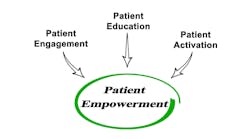According to the 2007 HIMSS Leadership Survey, which every year asks CIOs and IT directors to specify which IT technologies are most important to their healthcare organizations now and in the future, 54 percent of respondents indicated that “implementing technology to reduce medical errors and increase patient safety,” such as EMRs, is their organization’s top priority today.
According to the 2007 HIMSS Leadership Survey, which every year asks CIOs and IT directors to specify which IT technologies are most important to their healthcare organizations now and in the future, 54 percent of respondents indicated that “implementing technology to reduce medical errors and increase patient safety,” such as EMRs, is their organization’s top priority today.
The survey also indicated that, in 2007, 32 percent of respondents worked for an organization that already had a functioning EMR in operation, with another 37 percent indicating that their organizations were in the process of installing an EMR, and another 6 percent indicating that their organizations had signed contracts with vendors to have an EMR installed. Apparently, 75 percent of the survey’s respondents (representing nearly 700 hospitals in 306 healthcare organizations) work for organizations that are firmly committed to the concept and implementation of an EMR.
However, most mainstream media reports generally trumpet the “lackluster” interest by care providers in EMRs. Usually, only the first statistic — that “just” 32 percent of all healthcare organizations use an EMR — gets included in these reports.
Why aren’t more media outlets reporting that 75 percent of healthcare organizations are at some stage of EMR adoption? Probably for the same reason your local weatherman reports that there’s a “20 percent chance it will rain today,” rather than an 80 percent chance it’ll be sunny. Americans seem to care more about bad news than good; news producers would rather sensationalize their broadcasts than provide in-depth analyses; and plain lazy reporters and news anchors simply parrot what comes off the Associated Press wire service.
If I sound bitter, it’s because I am. This apathetic, comatose reporting on healthcare propagates outright lies into the general knowledge base, which hurts us all, such as the incorrect and often-cited statistic that 47 million American’s are uninsured. This number, which comes from a U.S. Census Bureau report released in August of 2006, has become the most commonly used fabrication in news reports and political diatribes today. The report also states that of the 46.6 million polled about 10 million aren’t American citizens, millions more are currently eligible for Medicare coverage but haven’t applied, and millions more earn greater than $50,000 per year and simply choose not to obtain coverage, even when it’s offered by their employers. These are inconvenient facts for those looking to club an uninformed public with a really big, scary statistic.
The report even includes a disclaimer stating that annual retrospective questioning is “less than ideal” when it comes to accurately gauging insurance coverage in America, and that it “more closely approximates the number of people who were uninsured at a specific point in time during the year, than the number of people uninsured for the entire year.” You won’t hear that in the nightly news broadcasts, even though all of this is easily researched on the Census Bureau’s Web site.
Which is my greater point. To stay truly informed one must look beyond the mainstream media. Visit healthcare organization and government agency Web sites, such as the HIMSS, AHIP and AHIMA sites, as well as the Health IT, AHIC and ONC sites on the U.S. Department of Health and Human Services Web site.
Of course, continue to rely on HMT for in-depth case histories, as well as, unbiased reporting on the latest legislative and industry trends effecting healthcare.
And, for goodness sake, stay positive. 2008 promises to be a banner year for healthcare IT.


